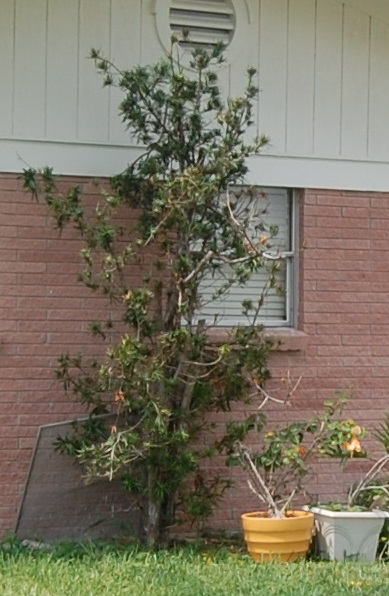A Lawn left to the plants which will grow
in South Texas (McAllen)
Most lawns in South Texas are of St. Augustine grass. Some have what is known as Coastal Bermuda, which has finer leaves.
My lawn started out some time before we bought the house, as St Augustine
with some Coastal Bermuda mixed in... in areas. After several periods of drought
and my irregular and infrequent watering, and the application of some natural (bovine)
fertilizer it developed to accept other species of plants which adapted to being mowed.
This is what happens when you let nature take its course, with one exception.
If the plant had stickers such as
(sand burrs = grass family Poaceae genus Cenchrus) or (burr clover = genus Medicago) it got pulled up.

The front lawn from looking from the southwest.

labeled version of the front yard lawn

a small leaved ground hugging vine - thrives best under the shade of the Ash tree

St. Augustine grass grows quite healthily under the shade of the Ash tree.
The plastic saucer weighted down with a brick is to give the wild birds a place to drink and splash about.

lawn ground cover mix - east side near fence

Front (North) face of house - trunk of palm tree (Sabal texana) on right
The tree behind it is a very old Rio Grande Ash = Mexican Ash = Berlandier Ash = Fraxinus berlandieriana

variegated leaf plant - has very small yellow flowers in season

Every now and then a patch of Tube Tongue = Justicia pilosella blooms with these violet colored flowers.

This plant with tiny (3 to 5 mm) yellow flowers is fairly common.

another tiny yellow flower

This moss rose - Portulaca grandiflora Family = Portulacaceae (the Purslanes). It occures naturally in front of our house.
It is native to Argentina, southern Brazil, and Uruguay. This one looks like an uncomplicated Brazilian variety.
The size of the blossom (1 cm) is much smaller than most cultivated varities.

Ruella - species ? - commonly called a petunia. It produces beautiful flowers which last a day.
There are 3 species of Ruella which occur in this area and which look much alike.
Ruella nudiflora - Ruella occidentalis - and - Ruella yucatana
The leaves on this plant most closely resemble R. yucatana . All are members of family Acanthacae.

Close-up of Bermuda grass with one of those tiny yellow flowers.

Bermuda grass Cynodon dactylon with dead patches due to extreme heat as well as water rationing.
It is native to East Africa, Asia, Australia and southern Europe, but not Bermuda.
It has optimum growth between 24 and 37 �C (75 and 99 �F), which is probably why it lives here.
-

decorative yew bush, was much fuller and taller
before the hail storm of 29 May 2012 nearly destroyed it.
The bush in the yellow pot is a yellow Hibiscus,
also much destroyed by the hail storm, and barely staying alive.

The yellow Hibiscus flowering, in better times, before hail storm.

Across the street the soccer fields have a planted border area.
On the left and under the palm trees (probably Washingtonia filifera), Live Oak = Quercus virginana
The short tree on the right with the white blossoms is locally called a Wild Olive or in Spanish, Anacahuita = Cordia boissieri.
~ ~ ~ ~ ~ ~ ~ ~ ~ ~ ~ ~ ~ ~ ~ ~ ~ ~ ~ ~ ~
